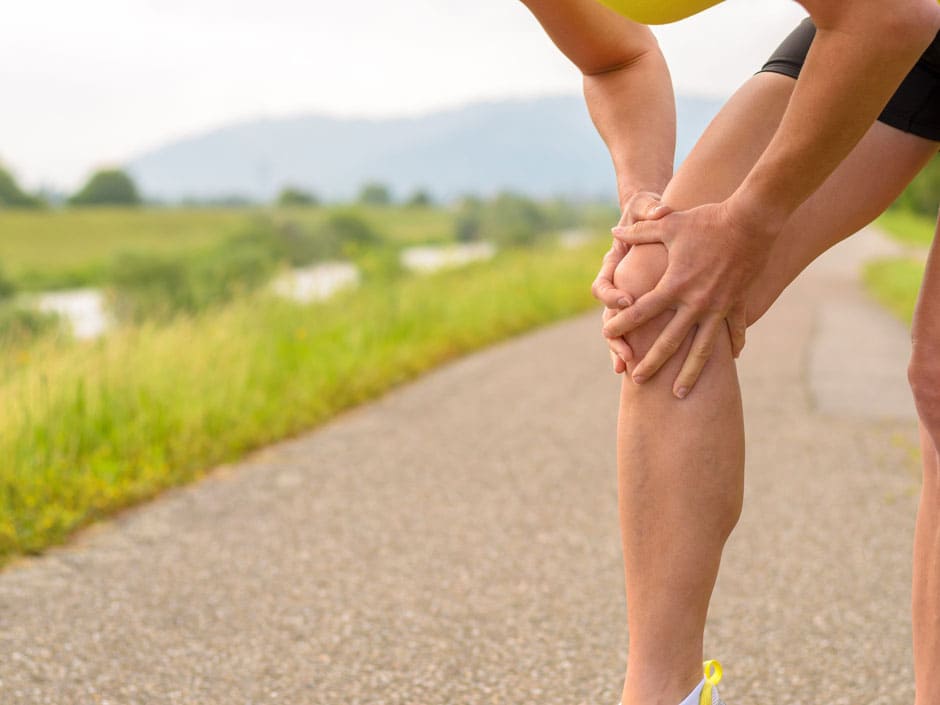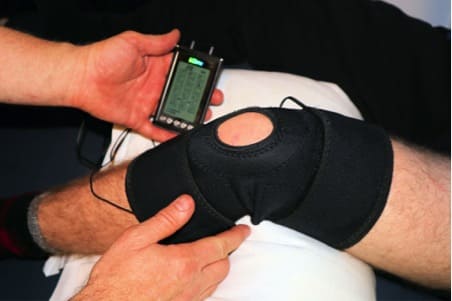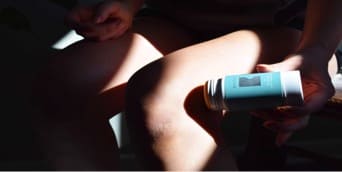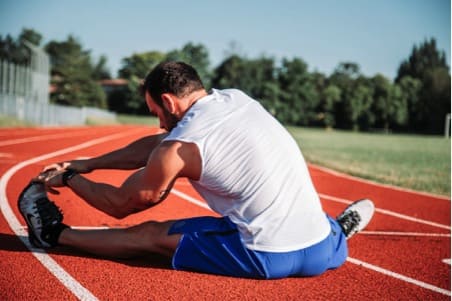Another day, another pain
10
July
2021

Knee pain is another common discomfort that hits people of all ages. With each stride, your knee is subjected to a force of five to eight times your body weight, making it the most stressed joint in the human body. In addition, your knees are built to handle millions of steps throughout a lifetime. So you heard it here first, don’t be surprised if you find out you have knee pain; all that stress they carry can sometimes lead them to fail.
According to Dr Metzl, “the knee is a hinge joint, meaning it works like a door hinge to straighten and bend in roughly 130 degrees of motion.” It's also strong, with a responsibility to endure the high pressures generated by all kinds of leg activities such as running, jumping, twisting, and skipping. In addition, the knee, unlike the hip and shoulder, which are both ball and socket joints, allows for less rotational mobility in exchange for more stability.
The knee joint is made up of three bones:
The femur, also known as the thigh bone, is the body's largest and strongest bone.
The patella, also known as the kneecap, lies within the quadriceps tendon in the front of the femur. It also slides up and down a slot in the front section of the femur called the trochlear groove each time the knee is bent.
The tibia is also known as the shin bone.
It is also made up of three ligaments that provide stability and strength to the knee:
The collateral ligaments run along the sides of the knee, limiting the knee's sideways mobility.
The anterior cruciate ligament (ACL) links the tibia to the femur in the middle of the knee and prevents the tibia from rotating or moving forward.
The posterior cruciate ligament (PCL), positioned directly below the ACL, prevents the tibia from moving backward.

What causes knee pain?
Although we have all these knee components that provide stability and prevent injuries, that might not be the case sometimes. So a lot of factors can contribute to knee pain; some of these factors are:
-
Injuries. Any of the ligaments, tendons, or fluid-filled sacs (bursae) that surround your knee joint, as well as the bones, cartilage, and ligaments that make up the joint itself, can be injured by a knee injury. The following are some of the most frequent knee injuries:
Injury of the ACL: It is a tear in one of the ligaments that link your shinbone to your thighbone. People who play basketball, soccer, or other activities that demand rapid changes in direction are more likely to get this type of injury.
Fractures: During falls or car accidents, the bones of the knee, especially the kneecap (patella), can be shattered. In addition, persons with osteoporosis might occasionally experience a knee fracture simply by taking an incorrect step.
Meniscus tear: The meniscus is a strong, rubbery cartilage that sits between your shinbone and thighbone and functions as a stress absorber. For example, if you quickly twist your knee while bearing weight on it, it might tear.
Knee bursitis: Some knee injuries induce inflammation in the bursae, which are tiny fluid sacs that cushion the exterior of the knee joint and allow tendons and ligaments to slide over it smoothly.
Patellar tendinitis: It is a condition that affects the patellar tendon. Tendinitis is a condition in which one or more tendons, thick, fibrous fibers that connect muscles to bones, become irritated and inflamed. An injury to the patellar tendon, which runs from the kneecap to the shinbone and allows you to kick, run, and leap, can cause inflammation. This type of injury can affect runners, skiers, bikers, and those who participate in jumping sports and hobbies.
-
Mechanical problems. The following are some examples of mechanical issues that might cause knee pain:
Loose body: A fragment of bone or cartilage might break off and float in the joint space due to injury or deterioration of the bone or cartilage. Unless the loose body interferes with knee joint mobility, the effect is similar to a pencil stuck in a door hinge, which may not cause any difficulties. According to Mayo Clinic (2019), “the effect is something like a pencil caught in a door hinge.”
Iliotibial band syndrome: This happens when the iliotibial band (a stiff band of tissue that runs from the outside of your hip to the outside of your knee) becomes so tight that it scrapes on the outside of your thighbone. Illiotibial band syndrome is more common among distance runners and bikers.
Dislocated kneecap: This happens when the patella, the triangular bone that covers the front of your knee, slides out of place, generally to the outside. The kneecap may remain dislocated in some situations, and the dislocation will be visible.
Hip or foot pain: If you’re experiencing hip or foot discomfort, you may want to alter your walking style to relieve the pressure on your troublesome joint. However, the changed stride might put additional strain on your knee joint, resulting in knee pain.
-
Arthritis. There are so many types of arthritis; those that might affect your knee include:
Osteoarthritis: Often known as degenerative arthritis, it is the most prevalent kind of arthritis. It's a wear-and-tear condition in which the cartilage in your knee deteriorates due to use and age.
Rheumatoid arthritis: It is a kind of arthritis that affects the joints and is the most severe. It is an autoimmune disease that may damage nearly every joint in your body, including your knees. Although rheumatoid arthritis is a chronic condition, its severity varies, and it can come and go.
Gout: Uric acid crystals form in the joints, causing this kind of arthritis. Gout most frequently affects the big toe, although it can also affect the knee.
Pseudogout: It is caused by calcium-containing crystals in the joint fluid and is frequently mistaken for gout. The most frequent joint afflicted by pseudogout is the knee.
Septic arthritis: It is a kind of arthritis that is caused by bacteria. Swelling, discomfort, and redness can occur when your knee joint becomes infected. Septic arthritis is characterized by a fever and the absence of trauma before the pain starts. However, it may swiftly destroy the cartilage in the knees. Therefore, you should consult your doctor straight away if you experience knee pain and any of the signs of septic arthritis.
Other conditions. Patellofemoral pain syndrome refers to a pain that originates between the kneecap and the underlying thighbone. It's prevalent in athletes, young people, especially those whose kneecaps don't track well in their grooves. Elderly individuals generally develop it as a result of kneecap arthritis.

Diagnosis
During the physical examination, your doctor is likely to conduct the following:
Check swelling, discomfort, tenderness, warmth, and apparent bruises.
Examine how far your lower leg can be moved in various directions.
Push or tug on the joint to assess the structural integrity of your knee.
Depending on your case, your doctor might also suggest one or a few tests of the following:
X-ray: can reveal bone fractures and degenerative joint disease, may be recommended first by your doctor.
CT scan (computerized tomography): can generate cross-sectional pictures of the inside of your body by combining X-rays obtained from various angles. They can be used to look for bone abnormalities and minor fractures. For example, even if the joint isn't inflamed, a specific type of CT scan can effectively detect gout.
Ultrasound. Sound waves are used to create real-time pictures of the soft tissue structures within and around your knee with this technique. During the ultrasound, your doctor may want to move your knee into various positions to detect particular problems.
MRI (Magnetic resonance imaging): creates 3D pictures of the interior of your knee using radio waves and a strong magnet. This test effectively detects soft tissue injuries, including ligaments, tendons, cartilage, and muscles.
Lab tests: If your doctor detects an infection or inflammation, they will ask for blood tests and perhaps an arthrocentesis technique, in which a tiny amount of fluid is taken from within your knee joint with a needle and submitted to a laboratory.
Enough chitchat, and let’s get on with your treatment options
-
Self-care:
Rest by taking a break from your daily activities and not applying pressure to the knee by standing up or walking.
Ice your knee to relieve pain and reduce inflammation.
Apply heat if you want temporary pain relief.
Use compression bandages to prevent fluid build-up.
Elevate your leg by resting it on a pillow.
Medicine: Your doctor may recommend drugs to alleviate pain and address the underlying diseases that are causing your knee discomfort, such as rheumatoid arthritis or gout. You can also take off-the-counter medication such as paracetamol, ibuprofen, or even creams such as lidocaine, or capsaicin, for pain relief.
Physical therapy: Depending on the cause of your discomfort, your doctor may suggest physical therapy or other forms of strengthening activities. Your knee will become more stable if you work on the muscles around it.
Exercise: If you are physically active or participate in sports, you may require workouts to correct movement patterns that hurt your knees and create proper technique while doing your sport or activity. Exercises that increase flexibility and balance are also beneficial.
Arch supports: The wedges on one side of the heel or your shoe might assist in transferring pressure away from the osteoarthritis-affected knee. In addition, different types of braces may be used to protect and support the knee joint in particular circumstances.
Injections: Your doctor may recommend injecting medicines directly into your joint in some situations, such as corticosteroids, hyaluronic acid, and plasma with a high concentration of platelets (PRP).
Surgery: If you have an accident that may require surgery, you don't always need to have it done right away. Consider the advantages and disadvantages of both nonsurgical rehabilitation and surgical reconstruction in proportion to what's most essential to you before making a decision. If you decide to have surgery, you may have the following options:
Arthroscopic surgery.
Partial knee replacement surgery.
Total knee replacement.
Osteotomy.

How can you prevent all this?
Stay light by maintaining a healthy weight.
Exercise, stretch, stay active.
Be a perfectionist by performing your sport precisely.
Be smart by choosing the right sport for you and your condition.
If you or anyone you know is suffering from pain, call us today on (469) 562 4188 to book an appointment with our expert doctors.